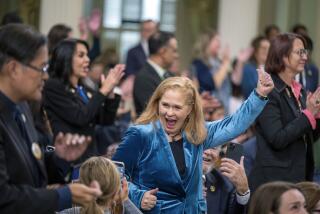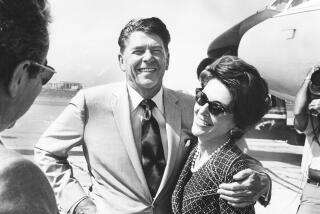NEWS ANALYSIS : Wilson Last of Reagan Class of 1967 as GOP’s Leadership Ranks Thin
The inauguration of Ronald Reagan as governor in 1967 seemed to signal a golden era for California’s Republican leadership with a powerful lineup of stars positioned to capture the state’s top elective jobs for decades to come.
Last week, Pete Wilson, one of those who rose from the Reagan era, was sworn in as California’s 36th chief executive. But Wilson is the only survivor of the Class of ’67. Behind him, the GOP leadership ranks have thinned considerably.
While Republicans have occupied the governorship 16 of the last 24 years, Democrats hold nearly all the other statewide offices. The only exception is Atty. Gen. Dan Lungren, elected in a photo-finish contest last November over a little-known Democrat.
By contrast, the Democrats have controlled both houses of the state Legislature all but two years since Reagan was elected governor. They have held a commanding margin in the state’s 45-member delegation to the U.S. House of Representatives. Most of California’s big-city mayors also are Democrats.
Wilson’s decision to replace himself in the U.S. Senate with Republican John Seymour served to underscore the Republicans’ lack of powerful statewide electoral players. The rare Senate appointment was a political plum that should have gone to a veteran with a proven capability of holding the seat for the GOP. Instead, Wilson turned to an Orange County state senator with little name recognition who lost his only statewide test to another state senator from the same county.
“The problem is the Republicans don’t have any bench,” said Democratic political consultant Clint Reilly, borrowing a sports cliche. “When you stack Seymour up against the other options, he is one in a line of weak candidates.” The GOP dilemma, according to former officeholders and consultants, is that moderate, problem-solving Republicans capable of winning statewide office often have lost primary election challenges from the party’s right wing. But then the surviving conservatives generally failed to develop the broad voter appeal needed to defeat Democrats in general elections. Those conservatives who did get to the Legislature or other offices had difficulty moving further up the political ladder.
Once well-financed Democrats became entrenched incumbents, they easily brushed off Republican challengers. Eventually, discouraged GOP newcomers began to turn elsewhere for careers.
In fact, Republicans did not even have an obvious successor to George Deukmejian when he announced in late 1988 that he would not run for a third term as governor. They had little choice but to turn to Wilson, who had just been reelected to the U.S. Senate. As a result, Wilson’s old Senate seat has suddenly become a competitive prize that will surely draw a strong field of Democrats. It is a seat the GOP can ill afford to lose.
Former Republican Assemblyman William T. Bagley of Marin County said the Republican Party today boasts few real activists with the kind of broad voter appeal to assure the party victory in such a contest.
“Earl Warren was an activist district attorney,” said Bagley, a San Francisco lawyer and University of California regent. “Goodwin J. Knight was an activist judge.” Both later were elected governor in the years before Reagan came to power. Bagley also noted that former Sen. S.I. Hayakawa won statewide visibility as a tough university president during the Vietnam War protest days.
But that pattern began to change with Reagan’s election and a tendency for California Republicans to choose more conservative candidates who appealed to disgruntled voters by running against the institution of government.
“You can start with the view that Republicans don’t like to govern,” said pollster and political analyst Mervin Field. “They run against government. As a result, it doesn’t attract the people who really want to govern.”
Wilson is an obvious exception. While Deukmejian has been portrayed as a governor who largely said no to programs, Wilson is considered a proactive Republican, a moderate and a doer who wants to use government to solve problems.
Another exception is former Rep. Ed Zschau, the Silicon Valley entrepreneur who very nearly upset Democratic Sen. Alan Cranston in 1988 and is considered a likely candidate for the seat that Cranston is vacating in 1992.
Zschau, who qualifies as the sort of activist cited by Bagley, had topped the lists of many observers as Wilson’s likely successor. But Zschau asked not to be considered, saying he was not prepared to leave his business at this time.
When Reagan took office in 1967, he was accompanied to Sacramento by a flock of talented Republican officeholders including Lt. Gov. Robert H. Finch, Controller Houston I. Flournoy, state Sen. Deukmejian and a group of vigorous moderate Republican Assembly members known as the Young Turks. They included Robert T. Monagan, William T. Bagley, John G. Veneman, Frank Murphy Jr., Paul Priolo and a young freshman from San Diego, Pete Wilson. Democrats held only one statewide office, attorney general.
One by one, the activist Republicans ran for statewide office. And one by one, most of them were defeated in GOP primaries, primarily by little-known conservatives, some of whom had the support of Reagan’s wealthy backers. The conservative GOP nominees then lost to Democrats in the subsequent general elections.
Challengers were not the only ones to succumb to the party’s conservative-moderate schism.
Sen. Thomas H. Kuchel, who had become a prominent and respected senator, was defeated by conservative state schools chief Max Rafferty in a bitter 1968 Republican Senate primary. This opened the way for Democrats to capture the seat, with Cranston defeating Rafferty in the fall election.
Deukmejian, then considered a moderate, ran for attorney general in 1974, but finished a distant fourth. He came back in 1978 to win as attorney general and, in 1982, moved to the governorship.
As reflected in Deukmejian’s rise, the Reagan phenomenon did usher in an era of California Republican leaders who generally ran against government. Their ranks were bolstered by anti-tax crusaders who came to office during the Proposition 13 tax revolt. These Republicans succeeded in holding the line on taxes, but distinguished themselves with a broad enough political agenda to move on to higher office.
Wilson was able to rise despite all the roadblocks partly because of his decision to leave the Legislature and run a successful campaign in 1971 for mayor of San Diego. Although he lost his first statewide race, finishing fourth in the 1978 gubernatorial primary, things changed for Wilson two years later.
Incumbent Republican Sen. Hayakawa was being criticized for failing to put enough energy into the job and decided not to run again. Then the acknowledged front-runner for the post, conservative former Rep. Barry Goldwater Jr., unexpectedly faltered. Wilson won the primary with 37.5% of the vote and went on to defeat a politically wounded Edmund G. (Jerry) Brown Jr. for the Senate seat in November.
Of the other Assembly Young Turks who came to power during the Reagan era, only Flournoy succeeded in winning a statewide GOP primary, for governor in 1974. He lost to Brown in the November runoff and subsequently dropped out of active politics.
Today, Atty. Gen. Lungren qualifies as one of the GOP’s rising stars because of his November victory. But Lungren’s future on the statewide political canvass is uncertain in large measure because of his conservative, anti-abortion views.
Meanwhile, Democrats have a long list of potential candidates standing by for statewide contests. They include former San Francisco Mayor Dianne Feinstein, who ran a credible race in losing the governorship to Wilson, Treasurer Kathleen Brown, Controller Gray Davis, Lt. Gov. Leo T. McCarthy, schools chief Bill Honig and the state’s first elected insurance commissioner, John Garamendi.
Democrats also have several House members who are running--or considering it--for the two Senate seats at stake in 1992. They include Reps. Barbara Boxer, Bob Matsui and Mel Levine.
One problem for California politicians of both parties as they pursue their ambitions is the relative lack of turnover in elective posts during the last two decades. But that dynamic may soon change.
Reapportionment will give California seven new House seats, for a total of 52. The new term limits on state legislative and executive offices are prompting incumbent lawmakers to look to spots in Congress, opening up more legislative seats than is normal in a reapportionment year. By the mid-1990s, the term limits approved by voters in November will prompt a wholesale opening of state elected positions.
This will create opportunities for local political leaders--mayors, council members and county supervisors--to move up to the Legislature. The turnover is expected to attract more women and members of ethnic minorities to all levels of California electoral politics.
The promise of change may be exciting to political observers and potential candidates, but not an enticing prospect for state Senate President Pro Tem David A. Roberti (D-Los Angeles) as he joins Wilson and other leaders in grappling with critical state problems.
“It’s going to be very difficult around here because it’s going to be musical chairs,” he said.
More to Read
Get the L.A. Times Politics newsletter
Deeply reported insights into legislation, politics and policy from Sacramento, Washington and beyond. In your inbox three times per week.
You may occasionally receive promotional content from the Los Angeles Times.










